Transform your traditional Spanish paella into an eco-friendly outdoor adventure by harnessing the sun's power. You'll need a solar cooking station with a dual-box design, reflective surfaces, and proper insulation to achieve temperatures between 175-190°C. Start by preparing your sofrito base, then layer your ingredients precisely – from proteins to perfectly washed Bomba rice. Keep adjusting your reflector every 30 minutes while monitoring temperature and weather conditions. With patience and proper timing, you'll develop that coveted crispy socarrat bottom layer. The combination of solar cooking techniques and authentic Spanish ingredients will reveal flavors you've never experienced before.
Essentials for Solar Paella Setup
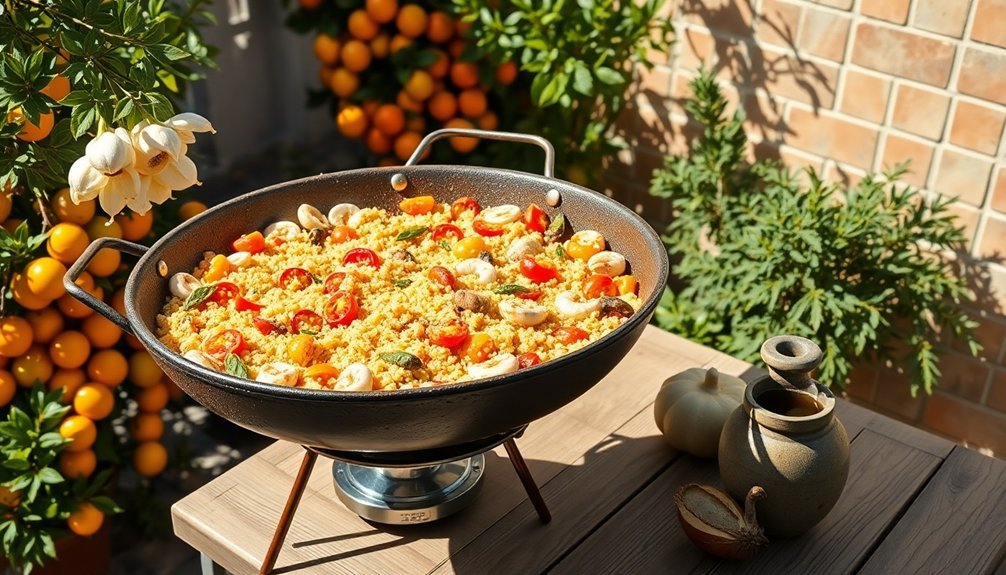
Your setup location is essential for success. Position your solar cooker in a spot with maximum sun exposure, like a driveway, ensuring it's level and stable.
You'll need to adjust the reflector every 30 minutes using a cardboard tracker to maintain ideal sun alignment throughout the cooking process.
For your cooking vessel, combine a metal bowl inside a glass bowl to maximize heat retention. Cover the setup with a lid or tinfoil, and add a kitchen towel for extra insulation. Adding saffron threads early ensures proper infusion of its signature color and flavor throughout the dish.
You'll need to monitor the cooking process for 2-4 hours, depending on sunlight conditions. Check the paella's progress every half hour, adjusting cooking time based on cloud cover and sun intensity while watching for proper liquid absorption and rice tenderness.
Preparing Your Ingredients
Before diving into the cooking process, proper ingredient preparation sets the foundation for an authentic Spanish paella. You'll need to start by selecting Bomba or Calasparra rice, washing it gently in cold water to remove excess starch, and letting it dry. These short-grain varieties from Valencia are essential for achieving the perfect texture and absorption of flavors. A properly prepared sofrito base creates the foundational flavors that define traditional paella.
For your proteins and vegetables, precision in preparation makes a significant difference. Cut your seafood into appropriate portions, with squid in rings and tentacles whole. If you're using chicken thighs, consider deep-frying them until brown and crispy. Chop your onions, peppers, and deseeded tomatoes uniformly, and finely mince the garlic.
- Stock Preparation: Have your fish or chicken stock ready before starting, as it's the foundation of your paella's flavor.
- Spice Organization: Measure out your saffron threads (1-2 pinches) and paprika in advance.
- Mise en Place: Arrange all ingredients in order of use: olive oil, proteins, vegetables, rice, and stock.
Remember to add peas near the end of cooking to maintain their texture and vibrant color.
Building The Solar Cooking Station
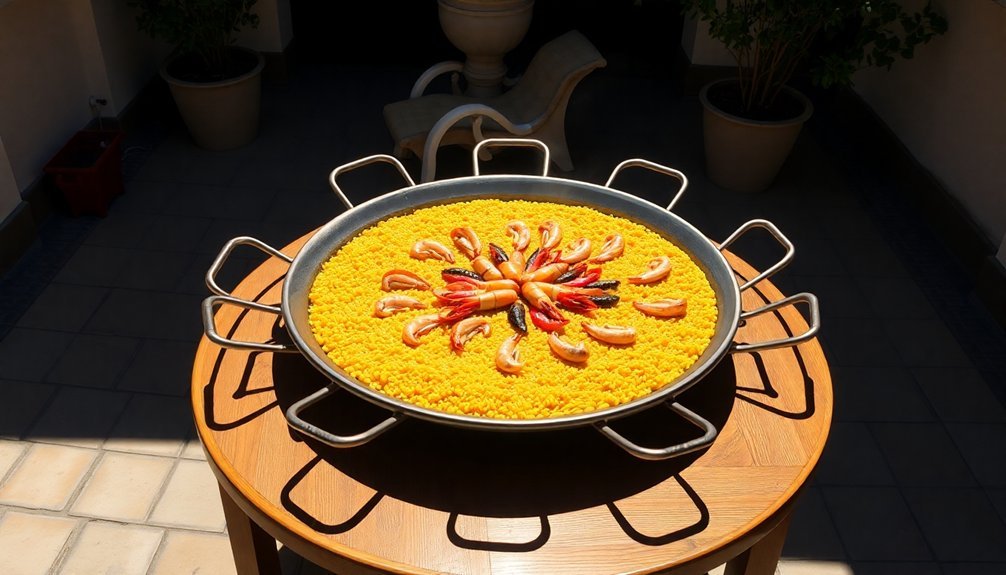
In accordance with traditional paella preparation methods, building a solar cooking station requires careful assembly of two main components: the insulated box structure and its reflective elements. You'll need to construct a double-box system using wooden materials, with the smaller box fitting inside the larger one. The setup is designed for preheating capabilities, ensuring proper temperature before adding ingredients.
| Component | Action Required |
|---|---|
| Outer Box | Install wooden bracing and aluminum case |
| Inner Box | Paint interior black for heat absorption |
| Insulation | Pack rice husk/wool between boxes |
| Glass Cover | Mount dual-pane glass with aluminum frame |
| Reflector | Attach hinged aluminum sheet/mirror |
Start by assembling the outer box with its aluminum casing, then position the smaller box inside. Fill the gap between them with your chosen insulation material, securing it with a wooden frame and screws. Install the dual-pane glass cover using hinges for easy access. Paint the inner box's surface black to maximize heat absorption. Mount your reflective panel using adjustable supports – you'll need to modify its angle throughout cooking to maintain ideal sun exposure. Position your paella pan centrally when the station's complete. The setup should maintain temperatures between 120-150°C, perfect for traditional paella cooking.
Rice and Stock Techniques
Your success with paella depends heavily on maintaining the proper ratio of hot stock to rice, typically using 3 cups of stock for every cup of short-grain rice.
You'll want to keep your cooking liquid at a consistent temperature throughout the process, adding only hot stock to prevent disrupting the rice's cooking rhythm.
While the rice simmers, it'll naturally absorb the rich flavors from your stock and other ingredients, creating layers of taste that define an authentic paella.
Stock-to-Rice Ratio Basics
Getting the perfect stock-to-rice ratio stands as one of the most critical elements in crafting authentic Spanish paella.
You'll want to maintain a basic ratio of 1 part rice to 3.5 parts liquid, which typically translates to 2 water glasses of rice for every 5 water glasses of stock.
When using traditional Bomba or other short-grain Spanish rice varieties, this ratio will serve you well, as these types can absorb three times their volume without breaking down.
For the most reliable results, follow these essential measurements:
- Start with the 1:3.5 base ratio for Bomba, Bahía, Valencia, or Calasparra rice
- Keep extra hot stock ready, as you might need to adjust based on seafood liquid release
- Monitor the consistency – rice should absorb liquid while maintaining slight firmness
Cooking Liquid Temperature Control
Proper temperature control builds directly upon the stock-to-rice ratio fundamentals, forming another cornerstone of perfect paella preparation. You'll need to maintain your stock at a consistent hot temperature before it ever touches the rice. Start by boiling your stock until it reduces to its original level, concentrating those essential flavors.
| Time Point | Temperature | Action |
|---|---|---|
| Preparation | High heat | Boil and reduce stock |
| Initial Add | Hot | Pour stock over rice |
| First 5 min | High heat | Bring to rapid boil |
| Mid-cook | Medium-low | Steady absorption |
| Final stage | High heat | Create socarrat |
When cooking outdoors, you'll add the hot liquid first, followed by other ingredients. Don't stir after combining the rice and stock – this helps develop the coveted socarrat. Instead, rotate your pan every 5 minutes for even cooking. If you notice the rice surface remaining hard while liquid disappears, add more hot stock by the spoonful. You'll know you're near completion when you hear the characteristic popping sound, signaling the formation of that prized crispy bottom layer. Remember to avoid covering the pan during cooking, as this prevents proper socarrat development.
Absorbing Flavors While Simmering
During the essential simmering phase, Spanish rice varieties like Bomba and Calasparra excel at absorbing the rich flavors of your stock while maintaining their distinct texture.
You'll want to maintain a steady simmer as these short-grain varieties work their magic, absorbing up to three times their volume in liquid without becoming mushy.
For maximum flavor absorption, you'll need to follow these important steps:
- Don't wash your rice beforehand – the outer starch layer helps capture and lock in the flavors from your broth.
- Coat the rice thoroughly in oil and seasonings before adding your hot stock, ensuring even distribution.
- Pour your hot broth slowly around the pan's edges, maintaining a 2:1 liquid-to-rice ratio.
Once you've added the stock, resist the urge to stir. Instead, give your pan a gentle shake to settle the ingredients.
You'll notice the rice gradually absorbing the rich flavors as it cooks uncovered for 15-18 minutes. If you see dry spots forming, carefully add a splash more hot stock without disturbing the rice.
This careful balance of liquid and heat will help develop those complex flavors you're aiming for.
Layering Your Paella Components
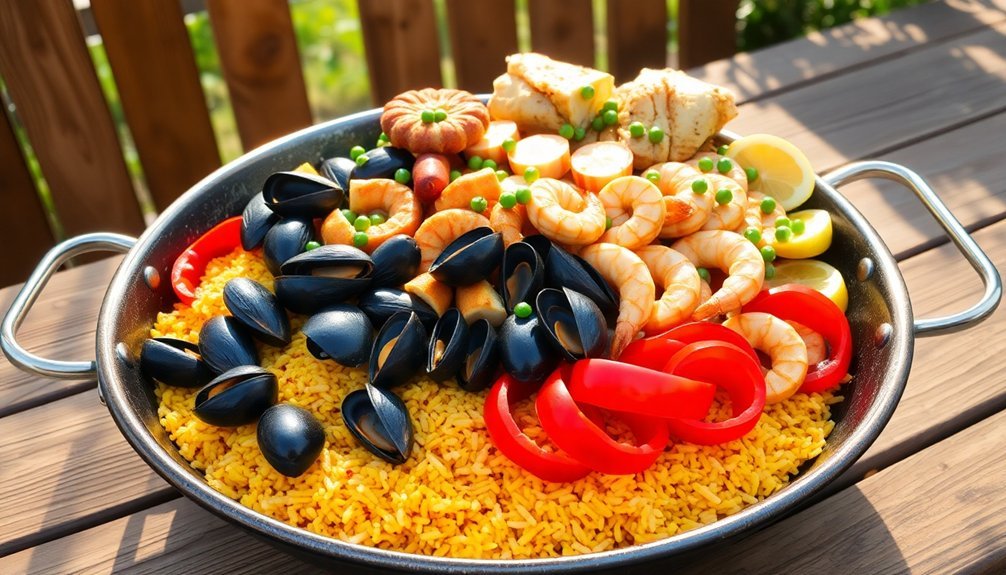
You'll want to start building your paella by spreading short-grain rice evenly across the bottom of the pan, making sure it's coated with seasonings and oil.
Next, arrange your proteins like chicken thighs and seafood on top of the rice, followed by a layer of finely chopped vegetables such as bell peppers, tomatoes, and onions.
Finally, you'll pour the saffron-infused broth over everything, allowing all components to cook together without stirring to achieve the perfect texture and that coveted socarrat at the bottom.
Bottom-to-Top Ingredient Order
Creating authentic paella relies heavily on layering ingredients in the correct order, starting with the aromatic base and building up to the final garnishes.
You'll want to begin with a generous layer of high-quality Spanish olive oil, sautéing your diced onions, bell peppers, and minced garlic until they're softened. Add your tomatoes and bay leaf to complete the aromatic foundation.
For the protein layer, you'll add your meats in order of cooking time:
- Start with chicken thighs and chorizo, allowing them to brown properly.
- Add calamari rings next, as they need time to become tender.
- Save your shrimp and mussels for later in the cooking process.
Once your proteins are cooking, it's time to add your rice, saffron, and paprika, stirring to coat the grains with oil and spices.
Pour in your broth and white wine, if using, and let the rice cook undisturbed. Add your seafood and peas during the final minutes of cooking.
You'll finish with fresh parsley and lemon wedges after the paella has rested for 10 minutes under cover.
Essential Texture Building Stages
Building authentic paella texture involves a careful sequence of steps that go beyond simple ingredient layering.
You'll need to start with proper rice selection – Bomba, Calasparra, or Albufera varieties will give you the firm, separate grains vital for authentic texture. Don't rinse the rice, as you'll want to preserve its natural starch content.
Before adding any ingredients, you must properly prepare your paellera by seasoning it with oil until it smokes.
Once you've laid your sofrito base, spread the rice evenly across the pan's bottom to guarantee uniform cooking. When you pour the saffron-infused broth, do it gently around the pan without stirring.
You'll need to maintain steady, even heat throughout the cooking process. Once you've added the broth, resist the urge to stir – this is essential for developing the prized socarrat layer at the bottom.
Watch the liquid levels carefully, adjusting heat as needed to prevent either drying out or mushiness. The rice should gradually absorb the broth while forming a crispy bottom layer, creating that perfect contrast between tender grains above and the caramelized socarrat below.
Monitoring Solar Cooking Progress
Modern technology has revolutionized solar cooking monitoring through sophisticated apps and sensors that track every aspect of the cooking process. When cooking your traditional paella in a solar oven, you'll benefit from real-time temperature tracking and precise solar position calculations that help maintain ideal cooking conditions.
You'll want to monitor three critical aspects during your solar paella cooking session:
- Temperature stability – Set up alerts to notify you when temperatures fall outside the ideal range for paella (usually 175-190°C), and verify your sensors are properly calibrated for accuracy.
- Solar positioning – Use the app's advanced SAMPA algorithms to adjust your cooker's position throughout the day, maintaining maximum energy absorption with precision down to 0.0003 degrees.
- Weather conditions – Track hyperlocal weather data at 90-meter resolution to anticipate changes in cloud cover or wind that might affect cooking times.
Your app will calculate thermal efficiency and cooking power in real-time, normalizing data to the standard 700 W/m².
Download your cooking session data afterward to analyze and improve your technique for future solar paella preparations. You'll receive smart notifications suggesting adjustments based on changing conditions, guaranteeing consistent results.
Achieving Perfect Socarrat Outdoors
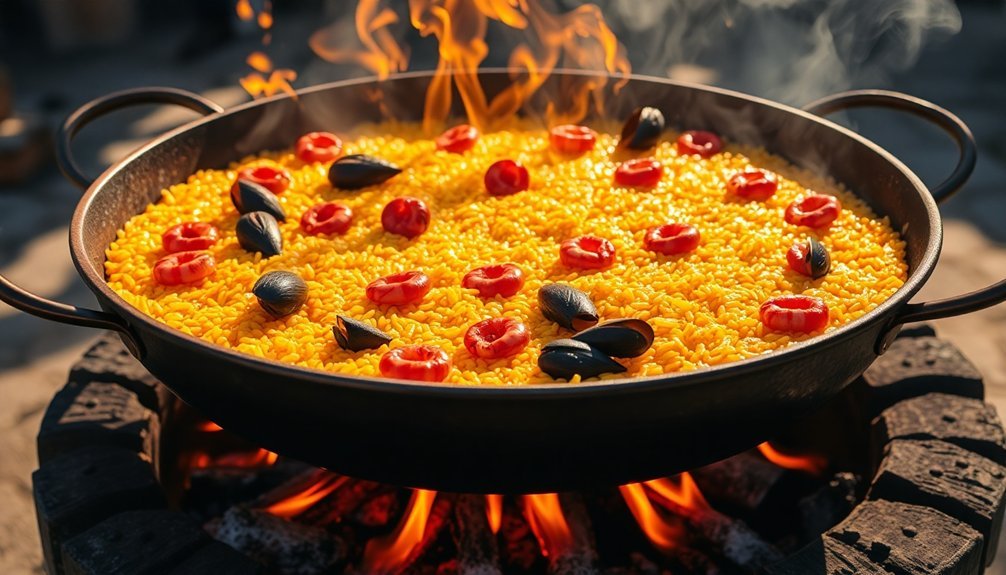
The elusive socarrat, that prized golden crust at the bottom of a paella, requires precise technique and setup when cooking outdoors.
You'll need a carbon steel paella pan between 16-18 inches wide, ensuring the rice layer isn't deeper than one finger's breadth for ideal crust formation.
Set up your cooking station with hardwood like hickory or oak, positioning the grill grate 8-10 inches above the flames.
You'll want to start your fire about an hour before cooking to achieve consistent heat. As you cook, rotate the pan frequently to maintain even heat distribution across the bottom surface.
When you're adding ingredients, start with oil, followed by proteins, and finally the rice and broth.
Listen carefully for a crackling sound as the broth cooks away – this signals that the socarrat is beginning to form.
You'll know you're close when the protective liquid between the pan and rice disappears, allowing the rice to start frying.
Remove your paella from the heat just before the last bit of broth absorbs, then let it rest for 10 minutes.
This resting period is essential, as it allows the socarrat to develop fully and firm up properly.
Frequently Asked Questions
Can I Substitute Regular Long-Grain Rice for Bomba Rice?
You shouldn't substitute long-grain rice for Bomba rice. It won't absorb flavors well, stays too loose, and can't create the proper texture. Instead, use Spanish short-grain alternatives like Senia or Calasparra.
What Do I Do if Clouds Appear During Cooking?
If clouds appear, you'll need to increase your fire's intensity and add more wood to maintain consistent heat. Keep a protective cover nearby and be ready to adjust cooking time if needed.
How Long Does Solar Cooking Typically Take Compared to Traditional Methods?
You'll need to plan for longer cooking times with solar cooking – it typically takes 1.5 to 3 times longer than conventional methods. For example, if something takes 1 hour traditionally, expect 2-3 hours solar cooking.
Will the Paella Taste Different When Cooked With Solar Power?
You'll notice a distinct taste when using solar power – it'll enhance natural flavors without any smoky overtones. Your paella will be more moist and tender, letting ingredients like saffron and spices shine through.
What's the Minimum Temperature Needed for Successful Solar Paella Cooking?
You'll need at least 180°F (82°C) for basic cooking, but for the best results, aim for 200-300°F (93-149°C). Your solar cooker should maintain these temperatures consistently throughout the cooking process.
In Summary
You've now mastered the art of solar-cooked paella, proving that traditional Spanish flavors don't require modern appliances. With your outdoor setup and careful attention to timing, you'll achieve that coveted socarrat every time. Whether you're entertaining guests or enjoying a sunny weekend adventure, you're ready to transform simple ingredients into an impressive feast using nothing but the sun's natural energy.

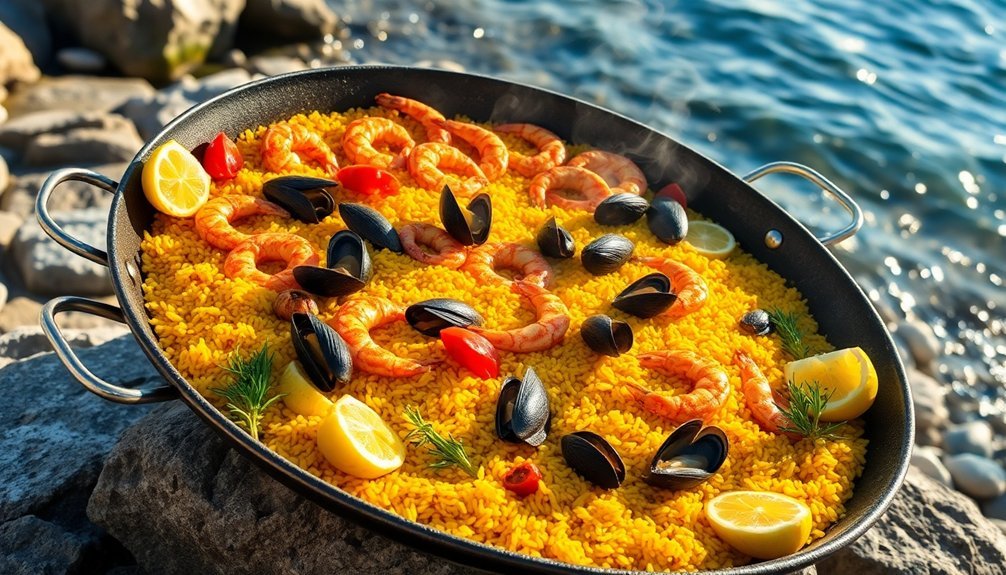



Leave a Reply